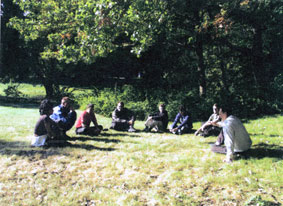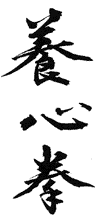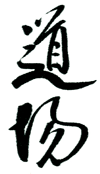| |
Dojo
etiquette
Entering and leaving the Dojo
• Remove outer clothes, hat, shoes, before entering the training area
• Bow and in several ryu “Osu” both entering and leaving,
• If higher grade persons enter with you, let them go first,
• Acknowledge Yudansha (black belts) with a bow and “Osu”
Greeting each other
• Mutual respect is important. This applies both in and out of the dojo.
• Always address your sempai/sensei/shihan with his/her title, in the
dojo, and private unless asked to do otherwise.
Class and Dojo etiquette
• Line up according to rank, if the same the order of date graded and
age decide, for the greet always go onto the left knee first then
right. Your senior grade should begin kneeling first.
• Training times should be respected, however if late, after changing,
enter the dojo, sit in seiza at the back of the dojo and wait for a
sign from the instructor for you to join, bow and respond with Osu and
join the group with vitality.
• If you need to leave a training early notify the instructor before
the training.
• Always address the instructor according to his or hers grade with
Sempai-Sensei-Shihan-Kaicho. If in doubt ask if possible before
training begins otherwise normally Sensei is fully accepted for black
belt from 3rd Dan and above.
• If you have any reason for not fulfilling all the training sequences
due to some injury or physical handicap the instructor should be
informed beforehand.
• If anything should happen during the training requiring you must stop
or leave the training area the instructor must be informed as help
maybe required.
• The higher grades must always show a good example to the others both
in technique quality, spirit, understanding, and assistance with
encouragement.
• Talking should be kept to an absolute minimum, explanations should be
done afterwards. Always stand and sit in a correct manner.
• Never turn your back to the sempai/sensei/shihan when
instruction/advice is being given, your full attention is required, so
that no misunderstanding is made and possible injury can be avoided,
respect should be shown to the sempai/sensei for his/her knowledge.
• If you need to make a break during the training e-g. To tidy your
dogi- training uniform, go down on your left knee, facing away from the
shinden/kamiza, but not placing your back to the shinden.
• In many dojo after the instructor has demonstrated the next technique
or made
a comment / adjustment for improvement, the class replies with Osu as a
reply of understanding and appreciation.
• At the end of training it is normal with the traditional line-up,
often a summary made by the sensei, maybe a carefully selected short
meaning for all to contemplate, maybe some information of future
activity, followed by the dojo oath.
Then Zazen meditation, finally the greeting “rei” and thank you in
appreciation for the training.
• Dojo comes from a word meaning “a place of enlightenment” as well as
training hall, so the building is treated with due respect, keeping it
clean and well looked after, This means all equipment, training area,
changing room, showers, toilets etc.
Code and etiquette in YOSHINKEN
When one reads the newspaper and the news seen on TV it is shocking to
see how needless and brutal, sick violence is increasing the world
over, even children are involved both as aggressor and victim. All
serious Budo organisations have a responsibility to ensure that every
precaution and effort is made to see that their members are made fully
aware of the code of behaviour and the consequences, we must do
everything possible to set exemplary standards which can give good
guidelines to an honourable way of life, and not only to be a champion
within the budo art itself.

Photo Åke Wall
|
|
There are considerable differences in Yoshinken as compared to the
traditional modern Japanese Budo systems, these being
• Training (Keiko) is held normally with very rare exception outside,
close to nature. No permanent dojo with inside training.
• The traditional training uniform (Dogi) of Karatedo, Judo, Kendo,
Iaido is not used. Normal sport clothes can be used.
• The Kyu grading system is not used.
• No formal grading is held.
• No tournament fighting is trained or encouraged.
• The normal warm-up and conditioning training is not done, as in
Karate.
• In being close to nature you are also closer to your natural self,
you appreciate the finer details which otherwise often go unnoticed, to
be accepted by nature without fear such as by animals puts another
dimension to your personal development.
With these points alone gives a
similarity to the Bujutsu way, so therefore several of the dojo
etiquette rules do not apply.
• Since we normally train in sport clothes ( the official Yoshinken
uniform is black
dogi trousers and Black or White Yoshinken Shirt ) these should be kept
clean and in good condition.
• Finger nails cut short, no rings, chains etc, worn during the
training.
• The instructor is always to be given his/her title of Sempai/Sensei
unless told otherwise.
• In arriving to the place of training (keiko) greetings to the
Sempai/Sensei or if not present commence with Standing Meditation
(Ritsu Zen).
• We use the bow of Japanese budo and the sign of respect as in Chinese
Wushu.
• When the Sempai/Sensei is giving instruction the correct courtesy
must be always given of no talking and attention paid to what is being
said or demonstrated.
• A correct position should always be held during keiko – no hands in
pockets, relaxed but alert, open and prepared for anything.
• If requiring to leave early the Sempai/Sensei should be informed
before.
• If unable to attend the regular training it is courtesy and respect
to contact the Sempai/Sensei, showing that you still have the interest.
• Absolutely no unauthorised demonstration, representation, training of
Yoshinken.
• However if ever a situation should occur always notify sensei as soon
as possible.
• Any visitor/guest to our keiko (training) should be properly
introduced.
• Any intending member should give a CV of his or hers background.
• We respect nature and therefore take responsibility in being a
“caretaker” particularly around our “dojo” area. Paper, tins, etc. all
rubbish to be removed.
• Always show an interest in helping new members, and encourage all who
are in need of it.
• During “Kumite” fighting practice always respect your partner,
advanced members must take into consideration an inexperienced person,
the same applies to those with any handicap. Start and finish every
partner training with a bow and appreciation for the time spent
together.
• Remember true Budo starts and finishes with respect.
• Always try to see the application of training to everyday life.
• Eat and drink with good taste and feeling, cigarettes and smoking are
not encouraged, drugs definitely have no place in Budo.
• In critical situations always look for the most effective way to
handle the aggression where in retrospect you can summarise that you
reacted well, physical force is not always the answer.
• Keep a good sense of humour, a good laugh, this eases tension on both
sides.
• Keep your belief, spirit and energy high do not be lead into ways
that contradict these.
• We have a tradition in Yoshinken after every keiko to enjoy a cup of
tea & cake together to stimulate a good healthy dialog between all
members, to discuss keiko, Budo/Wushu, in fact all topics.
In conclusion it is of utmost importance that we who are Shihan/Sensei,
Sifu/Laoshi respected leader of any serious martial way, all the
training hall/place etiquette, code of behaviour rules apply to us,
even to a greater extent since we must set the example, an open hand
and ear to all contact between those who have identical goals and share
the same respect is vital if we are to make any impact on this
senseless killing and misery caused by those who have lost their way.
True Budo should consist of:
• Knowledge
• Honesty
• Dedication
• Respect
• Humbleness
• Loyalty
• Harmony
Marshall McDonagh
Kyoshi Taikiken
Yoshinken Sweden
29th May 2005
|



